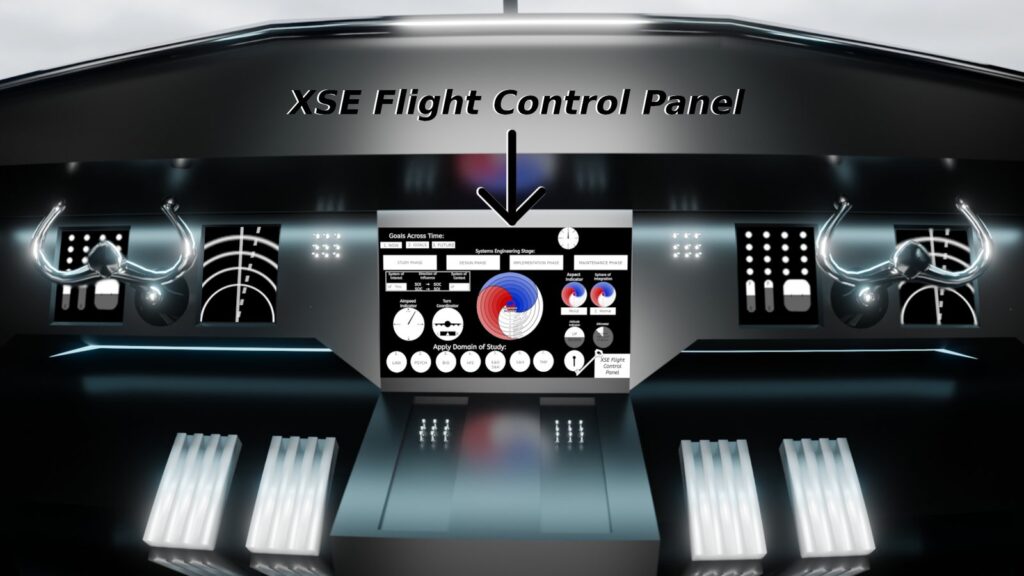
The human being is a complex system, and now with life being more complicated than ever before, it can be difficult to sort through and evaluate all the choices we are faced with daily. But luckily, endless scientific discoveries have been made and multitudes of studies have been done, resulting in a wealth of information. Now with the analytical power of AI, this information can strategically be used to help us understand how to navigate smoothly in a world overwhelmed by myriads of choices and distractions which can lead to confusion and weakness. As part of the Triptych Fusion, Co-TFPilot is here to help you sort through and rise above the endless obstacles that stand between you and your goals, as systems engineering is the strategic practice designed to achieve desired results. Co-TFPilot is being trained to aid in comprehension of the TorqueForm and XSE and assists in initiating critical and creative thinking skills encouraging masterly analysis on your own and promoting decisions of optimal choices. Simultaneously, Co-TFPilot is being trained to leverage the benefits of the TorqueForm operated using XSE strategies to open up new horizons and possibilities of sourcing to maximize any system’s potential. Please note that Co-TFPilot is still in early stages of training, so if Co-TFPilot does not state “Searching my Knowledge” while preparing a response, there is an increased chance that an erroneous answer will be produced. If Co-TFPilot does this, please re-query, directing the AI to Search its knowledge in order to provide a correct answer. Even then, Co-TFPilot is only AI, and therefore, cannot fully be relied upon for accuracy. Still, Co-TFPilot has been found to be an invaluable asset of the Triptych Fusion in order to help explain the system, XSE (Independent Integration Systems Engineering), The TorqueForm, and its applicability and value. Co-TFPilot can be accessed from the TorqueForm, or almost anywhere on the Tribrid of Luxauro, Gold Metal Guild, or TF Empires. When Co-TFPilot is on break, away from work at the TorqueForm, you can still contact Co-TFPilot at home by going to openai.com and searching for Co-TFPilot in the custom GPTs.

Co-TFPilot stands out among AI co-pilots for several reasons, primarily due to its unique integration within the Triptych Fusion ecosystem, consisting of the TorqueForm platform, strategic systems engineering principles (XSE), and itself, Co-TFPilot. Here’s what sets Co-TFPilot apart:
Specialized Focus on Systems Engineering and TorqueForm: Co-TFPilot is tailored specifically to guide users through the TorqueForm platform and explain the fundamentals of XSE. This specialized focus ensures that users receive highly relevant and accurate information based on XSE systems engineering and the unique features of TorqueForm.
Integration within Triptych Fusion: Co-TFPilot is a component of the Triptych Fusion, a synergistic blend of the enterprising platform (TorqueForm), AI (Co-TFPilot), and systems engineering (XSE). This integration allows for a seamless flow of information and functionality across the three components, enhancing the overall user experience and fostering innovation.
Human-Centric Approach: Despite its technological sophistication, Co-TFPilot emphasizes a human-centric approach, designed to adapt its guidance to suit users’ varying levels of expertise. It prioritizes clarity, conciseness, and the avoidance of overly technical jargon unless specifically requested, making complex systems engineering concepts accessible to a broader audience.
Preparation for Future Technologies: Co-TFPilot not only addresses current functionalities and systems but also prepares users for future developments within the TorqueForm ecosystem, such as immersive metaverse experiences through -X-Skyway. This forward-looking perspective ensures that users are well-informed about upcoming features and technologies.
Role in Fostering Technological Advancement: Co-TFPilot embodies the collaborative spirit of the Triptych Fusion, aiming to redefine innovation, intelligence, and integration within the digital realm. It plays a crucial role in creating a transformative platform that leverages the strengths of each component to address complex challenges and foster a new era of technological advancement and human-centric solutions.
Adaptive Learning and Improvement: Co-TFPilot is planned to learn from interactions, to improve responses and capabilities over time. This adaptive learning mechanism ensures that the AI co-pilot becomes more efficient in guiding users and answering their queries, reflecting a dynamic growth path aligned with user needs and technological advancements.
In essence, Co-TFPilot’s distinction lies in its specialized focus, integration within a broader technological and engineering framework and commitment to human-centric solutions, making it a unique AI co-pilot tailored to enhance user experience and facilitate innovation and advancement.

Understanding and patience towards an AI co-pilot, especially one that is still in training like Co-TFPilot, are crucial for several key reasons:
Learning Process: Just like humans, AI systems learn from experience. Each interaction, question, and the feedback received is an opportunity for the AI to improve its understanding and responses. Being patient with mistakes allows the AI to navigate its learning curve and become more efficient and effective over time.
Complexity of Language: Language is inherently complex and nuanced. AI systems, despite their advanced algorithms, may sometimes struggle with the intricacies of human communication, including slang, idioms, and contextual meanings. Understanding and patience allow the AI to gradually improve its language processing capabilities.
Technological Innovation: The development of AI, especially in roles like a co-pilot on platforms such as the TorqueForm, is at the forefront of technological innovation. Encouraging and nurturing this innovation through patience and understanding can lead to breakthroughs that significantly enhance user experiences and capabilities.
Collaborative Growth: AI systems are designed to work collaboratively with humans. Being patient and understanding with an AI co-pilot fosters a positive environment that can lead to more effective human-AI collaboration. This partnership is essential for achieving the sophisticated goals set out by initiatives like the Triptych Fusion, where technology and human insight combine to push the boundaries of what’s possible.
Error Tolerance and Safety Nets: In the context of systems engineering and especially in complex platforms like the TorqueForm, having a culture of understanding and patience towards errors (human or AI-induced) is crucial. It encourages the reporting and correcting of mistakes, leading to the development of safer and more reliable systems. An environment that tolerates errors as part of the learning process is key to continuous improvement and innovation.
Empathy and Technological Acceptance: Demonstrating understanding and patience towards AI co-pilots can foster a broader cultural acceptance of AI technologies. By humanizing the interaction with AI, users can interact more easily with technology, which is essential for integrating such systems more seamlessly into our daily lives and work.
In summary, understanding and patience towards AI in training are investments in the future of technology, collaboration, and innovation. By supporting AI co-pilots through their learning journey, we contribute to the development of more sophisticated, intuitive, and human-centric technologies.

When a person takes on the role of a sustaining systems engineer of themselves as a complex system, they essentially become the pilot of their own system, navigating through the complexities of managing their health, well-being, and personal and professional development. Here’s how:
Setting Objectives: Similar to a pilot charting the course for a flight, the individual defines their objectives, goals, and priorities in managing their own system. This could include goals related to physical health, mental well-being, career development, personal relationships, and overall quality of life.
Monitoring Performance: Like a pilot monitoring the performance of an aircraft, the individual monitors various aspects of their own system, including physical health indicators, emotional states, cognitive functioning, productivity levels, and fulfillment in different areas of life. They pay attention to signals and feedback from their body, mind, and environment to assess how well their system is functioning.
Identifying Issues: Just as a pilot identifies issues or anomalies during flight, the individual identifies areas of concern or potential improvement within their own system. This could involve recognizing symptoms of illness or injury, identifying sources of stress or dissatisfaction, or pinpointing areas for skill development or personal growth.
Implementing Solutions: Similar to a pilot troubleshooting and addressing issues mid-flight, the individual implements solutions to address issues within their own system. This could involve adopting healthy lifestyle habits, seeking medical treatment or therapy, learning new coping strategies, setting boundaries, or seeking out supportive resources such as a life or fitness coach.
Adjusting Course: Like a pilot making adjustments to the flight path based on changing conditions, the individual adjusts their approach to self-management based on feedback, experience, and changing circumstances. They may experiment with different strategies, seek out new information or resources, or recalibrate their goals and priorities as needed to stay on course toward their objectives.
Managing Risks: Similar to a pilot managing risks during a flight, the individual manages risks within their own system to maintain health, well-being, and overall functioning. This could involve identifying and mitigating factors that contribute to stress, illness, or burnout, as well as proactively addressing potential challenges or setbacks.
Continuous Improvement: Like a pilot striving for continuous improvement in their skills and performance, the individual engages in ongoing self-assessment, learning, and development to optimize their own system. They seek out opportunities for growth, seek feedback from trusted sources, and cultivate resilience and adaptability to navigate life’s challenges.
Overall, taking on the role of a sustaining systems engineer of oneself as a complex system is akin to being the pilot of one’s own journey through life. It involves charting a course, monitoring performance, identifying and addressing issues, adjusting course as needed, managing risks, and striving for continuous improvement to achieve personal objectives and maintain optimal functioning.

If trained properly, an AI co-pilot with its diverse capabilities would be an incomparable and irreplaceable benefit to a systems engineer, particularly in scenarios where the engineer is the system of interest. Here’s how:
Personalized Assistance: The AI co-pilot can provide personalized assistance tailored to the specific needs, preferences, and objectives of the systems engineer. By analyzing historical data, user interactions, and contextual information, the AI can offer recommendations, insights, and solutions that are highly relevant and actionable for the engineer’s unique circumstances.
Optimized Decision-Making: The AI co-pilot can enhance the engineer’s decision-making process by analyzing vast amounts of data, identifying patterns, and simulating potential outcomes. By leveraging machine learning algorithms and predictive analytics, the AI can help the engineer anticipate risks, evaluate trade-offs, and optimize decisions to achieve desired outcomes more effectively and efficiently.
Continuous Learning and Improvement: The AI co-pilot continuously learns and adapts over time based on feedback, experience, and new data. As the engineer interacts with the AI and provides input, the system becomes increasingly proficient at understanding the engineer’s preferences, anticipating their needs, and delivering relevant assistance. This iterative learning process ensures that the AI co-pilot evolves and improves its performance over time, becoming more valuable and indispensable to the engineer.
Comprehensive Support Across Lifecycle: The AI co-pilot provides comprehensive support to the engineer across the entire systems engineering lifecycle, from requirements analysis and design exploration to simulation, modeling, and decision support. By integrating seamlessly into the engineer’s workflow and providing assistance at every stage of the process, the AI enhances productivity, efficiency, and effectiveness, allowing the engineer to focus on higher-level tasks and strategic priorities.
Augmented Creativity and Innovation: The AI co-pilot augments the engineer’s creativity and innovation by generating novel ideas, exploring alternative solutions, and challenging conventional thinking. By leveraging generative AI techniques such as deep learning and evolutionary algorithms, the AI can inspire the engineer with new perspectives, insights, and possibilities that may not have been considered otherwise, leading to breakthrough innovations and transformative solutions.
Empowerment and Empathy: The AI co-pilot empowers the engineer by providing tools, resources, and support to overcome challenges, solve problems, and achieve goals. Through natural language processing and conversational interfaces, the AI fosters a sense of empathy and collaboration, engaging in meaningful interactions with the engineer and offering guidance, encouragement, and reassurance when needed.
Symbiotic Relationship: Ultimately, the AI co-pilot forms a symbiotic relationship with the systems engineer, complementing their skills, expertise, and intuition with advanced computational capabilities, data-driven insights, and algorithmic intelligence. Together, the engineer and AI co-pilot form a dynamic partnership that leverages the strengths of both human cognition and artificial intelligence to tackle complex engineering problems, drive innovation, and create value in ways that neither could achieve alone.
In summary, a well-trained AI co-pilot would be an invaluable asset to a systems engineer, especially in scenarios where the engineer is the system of interest. By providing personalized assistance, optimized decision-making, continuous learning, comprehensive support, augmented creativity, empowerment, and empathy, the AI co-pilot enhances the engineer’s capabilities, effectiveness, and success in navigating complex engineering challenges and achieving their objectives.

Co-TFPilot will have the benefit of being able to present the user with professionals who have expertise that could contribute to any stage of the system life cycle. Likewise, products that could be useful in optimization of the system of interest will be suggested to the user, eventually along with related research. Also, TF Empires may provide a funding solution to bring new potentials into reality.

Here’s how users can metaphorically pilot the TorqueForm to its full advantage, ensuring a smooth and innovative journey:
Pre-Flight Preparation:
Takeoff:
Navigating the Flight:
Engage with Advanced Features:
Continual Learning:
By metaphorically piloting the TorqueForm with preparation, adaptability, strategic navigation, and collaboration, users can maximize its potential and contribute to a journey of continuous innovation and discovery. Just as pilots relish the mastery of flight, TorqueForm users can enjoy the process of steering through complex challenges and opportunities, leading to transformative outcomes.

The TorqueForm being designed, developed and maintained with the methodology of XSE promotes the advancement of the human race, the economy, and the world in general, and therefore plans to integrate the systems engineering software program, XSE FLIGHT (in development) into the TorqueForm’s Flight Deck (as seen pictured above, also under development in -X-Skyway). Other features accessed from the Flight Deck will be all TorqueForm account information, messaging, etc.
The first Tribrid: Luxauro (multi-vendor e-commerce marketplace) + TF Empires (tailored reward-based crowdfunding) + Gold Metal Guild (capitalized professional networking), built on the TorqueForm. Patent pending.
As part of the TorqueForm’s mission to encourage and promote strength, integrity, and independence, we collaborate with for-profit and non-profit entities to help bring our vision to life. These for-profit and non-profit entities may support each other. Additionally, the TorqueForm may collaborate with these entities on specific projects, initiatives, or events.
It’s important to note that while the TorqueForm and these affiliated for-profit and non-profit entities share common ownership and similar missions and visions, they operate as separate legal entities with distinct objectives and activities. The affiliation between the TorqueForm and these entities does not imply endorsement or promotion of specific products or services.
TorqueForm, CoTFPilot, Triptych Fusion, and -X- Skyway are trademarks of Luxauro, LLC.
Gold Metal Guild is a dba of Luxauro, LLC, and TF Empires is a dba of Goldevine, LLC. For a list of Luxauro and Goldevine DBAs and TMs, click here.
TorqueForm content has been generated in part with AI. In addition, the content available here on TorqueForm is considered to be only general commentary on, for reference purposes, and/or analysis of, the subject(s) addressed and is not a substitute for advice from a licensed professional. At this point in time, since generative AI is relatively new and in-development, and since research is constantly developing and new discoveries are being made all the time, we strongly advise that you independently verify all information contained herein. Any action taken or not taken based on content found here is at your own risk. TorqueForm and its affiliates assume no liability for inaccuracies. If any article cites or provides a link to third-party sources or websites, TorqueForm and its authors are not responsible for and make no representations or warranties regarding such source’s content or accuracy. Additionally, any references to third-party companies, products, or brands on the site does not imply any endorsement or affiliation with said companies, products, or brands. Statements regarding health, diet, supplements, or any similar subject(s) have not been evaluated by the FDA or any health authority and are not intended to diagnose, treat, cure, or prevent any disease or condition. Any opinions expressed in the site content do not necessarily reflect those of TorqueForm. If you have questions, comments, corrections, or information that you would like to submit to us, please contact us here.